On Thursday morning last week, New Yorkers woke up to an all-too-familiar sight. Sandbags lined ground-floor retail stores. Water pumps gushed water from basement garages. And the subway system, the stations and tunnels of which had flooded the night before, was largely suspended. The remnants of Hurricane Ida, which had torn through New Orleans earlier that week, discharged more than half a foot of water on the New York region. New York City was drenched in as much rainfall in one single hour as Chicago averages in a whole month.
As a result of climate change, storms and flash floods are becoming more severe and more frequent than ever in the United States. Cities need to brace themselves, but many of the solutions at play are exclusively engineering-driven, with hard barriers like seawalls and flood gates, which are prone to fail. When Hurricane Katrina made landfall in Louisiana, breaches in levees and floodwalls all over New Orleans left 80% of the city underwater. Likewise, in July this year, a dam along the river Rur in Germany couldn’t withstand the heavy flooding caused by Cyclone Bernd and burst, causing over 150 deaths.
So what should cities do to protect themselves? I reached out to five landscape architects and urban designers who have been invested in city-wide, design-driven initiatives against climate change for years. Some called for managed retreat, the controversial yet increasingly prescribed proposal to relocate people who are in high-risk zones. But for the most part, they agreed that such drastic measures may not be needed if cities adopt more resilient design strategies. That includes a mix of hard and soft infrastructure, with everyone agreeing that cities have to increase their ability to absorb water. Think permeable surfaces, green roofs, and other features that make room for water rather than pushing it back. In their telling, the city of the future is a sponge.
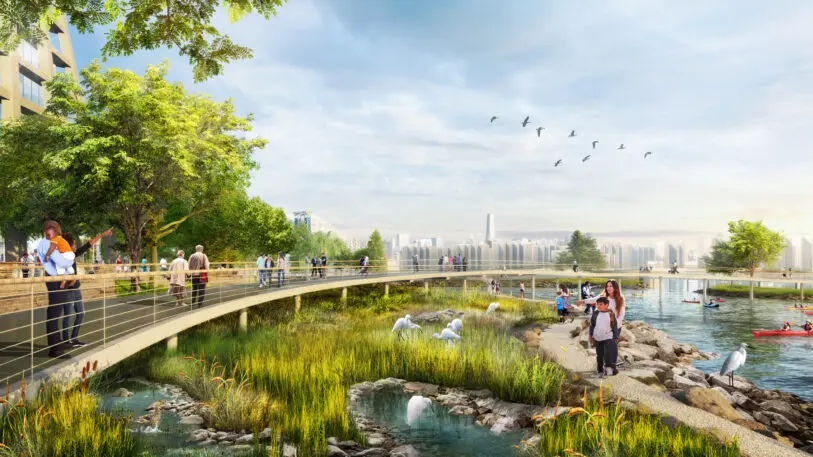
Take Sponge Park in Gowanus, Brooklyn. In 2016, the design firm DLANDstudio completed a pilot for the park, which re-directs, holds, and treats nearly 2 million gallons of stormwater per year. “Making city streets and roofs more permeable and sponge-like can help reduce flooding,” says Susannah Drake, a principal and founder of DLANDstudio. The technology to install sponge parks, bioswales, green roofs, and permeable pavers is available, Drake says, it’s just a matter of will. “Our parks and street tree planters can hold more water if designed and maintained properly,” she says. “It is a lot cheaper, and a lot more responsible, to maintain than it is to rebuild again, and again, and again, and again…”
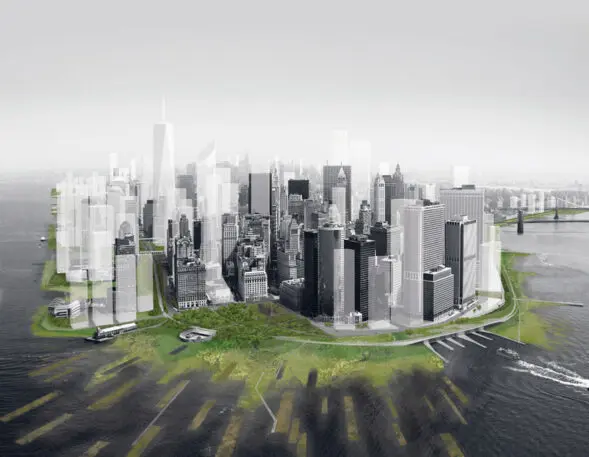
In 2010, the Museum of Modern Art invited DLANDstudio alongside Architecture Research Office to re-imagine Lower Manhattan in response to rising sea levels. The proposal featured two components: “a softened, buffered edge to manage storm surge and permeable streets for absorbing heavy rain,” Drake says.
Softness is key. As she points out, water will travel where it is pushed. “Hard walls can redirect water with disastrous consequence,” she says. Unlike landscapes that dissipate the force of a large wave, she says hard walls “give people a sense of false confidence.”
But time is a big constraint. “Curing concrete [to make barriers] takes 28 days, while it can take years for coastal landscapes to get established,” she says. “The key is a mix of both.”
Understand watersheds
Beka Sturges, a partner and principal of landscape architecture firm Reed Hilderbrand, echoed Drake’s sentiment. “Coastal areas need to become more spongy,” she says. “This means more trees, more soil, more green roofs, more porosity in the surfaces of our built environment.”

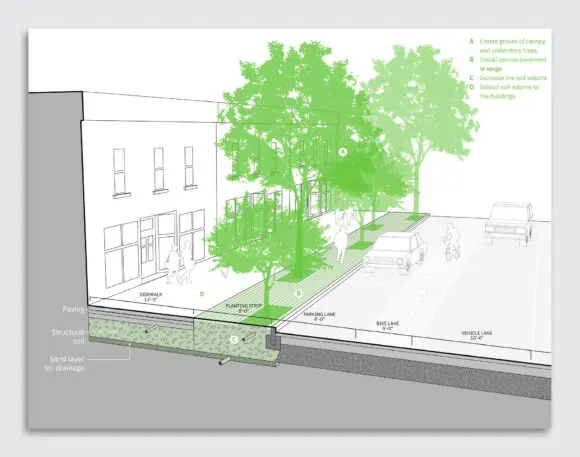
In Bridgeport, Connecticut, the studio is working on a project to protect the South End of the city from chronic and acute flooding. Sturges says the proposal relies on a “rigorously engineered seawall” combined with green infrastructure. “In general, I believe we should make room for water, but there are many situations where we need both,” she says.
Prepare for the worst—and protect the power grid
“Preparation and more preparation, that is what countries that are successfully supporting their urban economies have done,” says Claire Weisz, an architect and founding principal at WXY, an architecture and urban design studio that specializes in public spaces and resilient design.
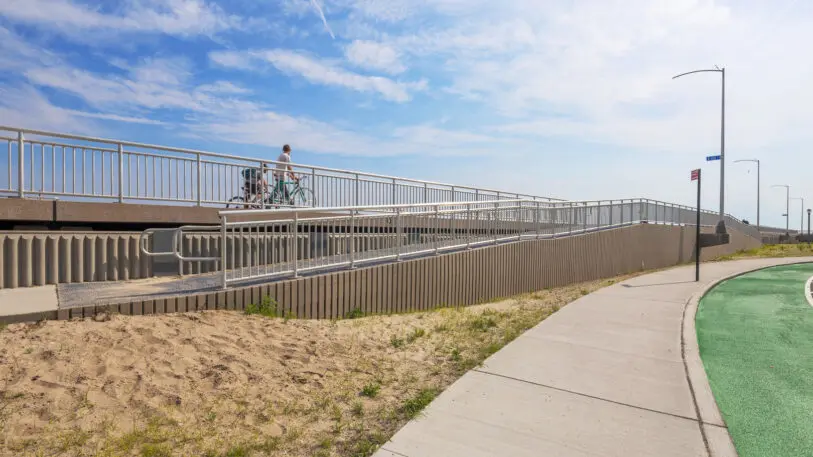
For Weisz, protecting the power grid is more important than building walls, particularly in low-lying neighborhoods like Red Hook and Greenpoint, both in Brooklyn, which are more prone to flooding than other parts of the city. “Power is critical to small business and flooding is very often followed by power outages,” she says. ‘Small business needs more access to alternative energy generation and battery powered energy storage.”
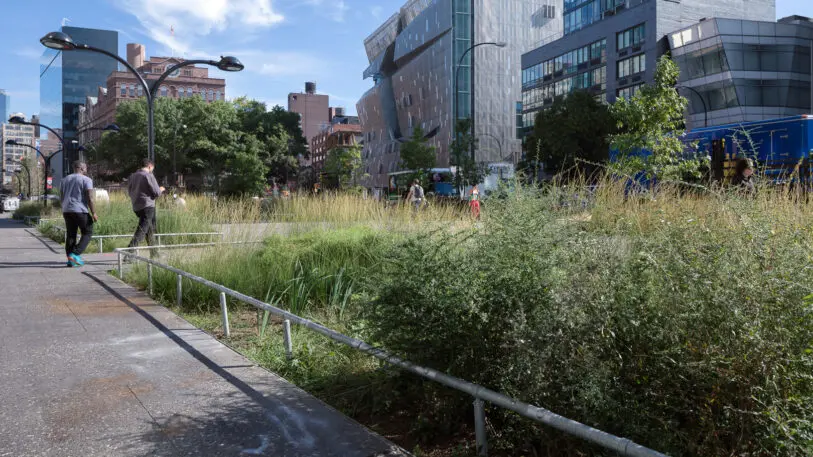
Consider all options
“Thinking out of the box and inventing creative responses that are informed and inspired by each particular situation marks the best way forward,” says James Corner, the founder and CEO of Field Operations, a landscape and urban design practice based in New York City. For Corner, the key to protecting cities lies in a dual approach: reducing impervious surfaces and increasing absorptive landscapes. The former category would target parking lots, roofs, and any hard surfaces where “stormwater simply gathers in quantity and momentum when it isn’t in any way absorbed or slowed down.” The latter would mean building more floodplains, wetlands, and marshes, but also investing in green roofs, pocket parks, and green infrastructure to help collect, store, and manage water.
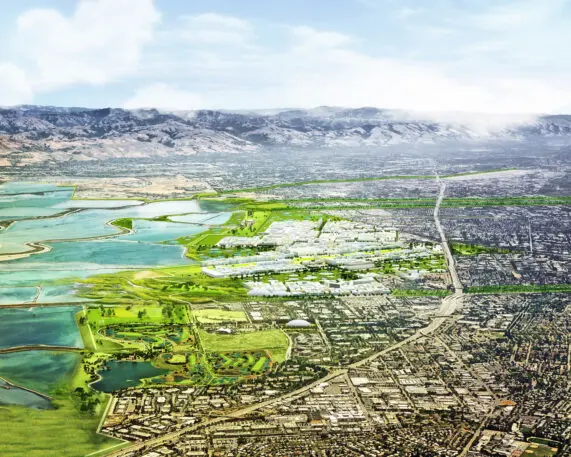
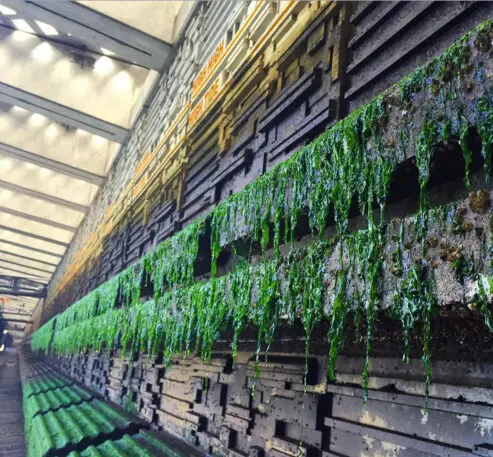
Managed retreat
Illya Azaroff, the director of design at +Lab Architect, and the founding co-chair of the AIA New York Design for Risk & Reconstruction Committee, has a similar perspective. “Ultimately, coastal cities need to rethink their living patterns, rezoning and moving people from flood zones through managed retreat over the long run,” he says. “Buyouts and relocation from identified critical high-risk areas should be initiated.”
To be clear, Azaroff is also a proponent of turning cities into sponges. He proposes increasing stormwater capacity with water harvesting cisterns, bioswales, and holding tanks on every building and property. “Ecosystems that absorb water to lessen the impact of disasters have multiple benefits including the ability to cool cities,” he says. “Let’s not forget that this should be an all-hazard approach and not a single hazard approach. Extreme heat is still the number one killer of all disasters.”
Recognize your brand’s excellence by applying to this year’s Brands That Matter Awards before the early-rate deadline, May 3.
